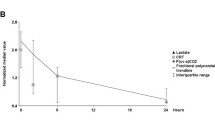Abstract
Purpose
To analyze the prognostic value of tissue oxygen saturation (StO2) in septic shock patients with restored mean arterial pressure (MAP).
Methods
This was a prospective observational study of patients admitted to the ICU in the early phase of septic shock, after restoration of MAP. Demographic data, severity score, hemodynamics, blood lactate, acid–base status, and StO2 were measured at inclusion followed by a transient vascular occlusion test (VOT) to obtain the StO2-deoxygenation (DeOx) and StO2-reoxygenation (ReOx) rates. Sequential organ failure assessment (SOFA) score was measured at inclusion and after 24 h.
Results
Thirty-three patients were studied. StO2 was 76 ± 10%, DeOx −12.2 ± 4.2%/min, and ReOx 3.02 ± 1.70%/s. MAP showed a significant correlation with VOT-derived slopes (r = −0.4, p = 0.04 for DeOx; and r = 0.55, p < 0.01 for ReOx). After 24 h, 17 patients (52%) had improved SOFA scores. Patients who did not improve their SOFA showed less negative DeOx values at inclusion. The association between DeOx and SOFA evolution was not affected by MAP. Both DeOx and ReOx impairment correlated with longer ICU stay (r = 0.44, p = 0.05; and r = −0.43, p = 0.05, respectively).
Conclusions
In a population of septic shock patients with restored MAP, impaired DeOx was associated with no improvement in organ failures after 24 h. Decrements in DeOx and ReOx were associated with longer ICU stay. DeOx and ReOx were linked to MAP, and thus, their interpretation needs to be made relative to MAP.



Similar content being viewed by others
References
Rivers E, Nguyen B, Havstad S, Ressler J, Muzzin A, Knoblich B, Peterson E, Tomlanovich M (2001) Early goal-directed therapy in the treatment of severe sepsis and septic shock. New Engl J Med 345:1368–1377
De Backer D, Ospina-Tascon G, Salgado D, Favory R, Creteur J, Vincent JL (2010) Monitoring the microcirculation in the critically ill patient: current methods and future approaches. Intensive Care Med 36:1813–1825
Myers DE, Anderson LD, Seifert RP, Ortner JP, Cooper CE, Beilman GJ, Mowlem JD (2005) Noninvasive method for measuring local hemoglobin oxygen saturation in tissue using wide gap second derivative near-infrared spectroscopy. J Biomed Opt 10:034017
Creteur J (2008) Muscle StO2 in critically ill patients. Curr Opin Crit Care 14:361–366
Gómez H, Torres A, Polanco P, Kim HK, Zenker S, Puyana JC, Pinsky MR (2008) Use of non-invasive NIRS during a vascular occlusion test to assess dynamic tissue O2 saturation response. Intensive Care Med 34:1600–1607
Creteur J, Carollo T, Soldati G, Buchele G, De Backer D, Vincent JL (2007) The prognostic value of muscle StO2 in septic patients. Intensive Care Med 33:1549–1556
Payen D, Luengo C, Heyer L, Resche-Rigon M, Kerever S, Damoisel C, Losser MR (2009) Is thenar tissue hemoglobin oxygen saturation in septic shock related to macrohemodynamic variables and outcome? Crit Care 13(Suppl 5):S6
Mesquida J, Gruartmoner G, Martinez ML, Masip J, Sabatier C, Espinal C, Artigas A, Baigorri F (2011) Thenar oxygen saturation and invasive oxygen delivery measurements in critically ill patients in early septic shock. Shock 35:456–459
Georger JF, Hamzaoui O, Chaari A, Maizel J, Richard C, Teboul JL (2010) Restoring arterial pressure with norepinephrine improves muscle tissue oxygenation assessed by near-infrared spectroscopy in severely hypotensive patients. Intensive Care Med 36:1882–1889
Levy MM, Fink MP, Marshall JC, Abraham E, Angus D, Cook D, Cohen J, Opal SM, Vincent JL, Ramsay G, SCCM/ESICM/ACCP/ATS/SIS (2003) 2001 SCCM/ESICM/ACCP/ATS/SIS international sepsis definitions conference. Crit Care Med 31:1250–1256
Dellinger RP, Carlet JM, Masur H, Gerlach H, Calandra T, Cohen J, Gea-Banacloche J, Keh D, Marshall JC, Parker MM, Ramsay G, Zimmerman JL, Vincent JL, Levy MM (2004) Surviving Sepsis Campaign guidelines for management of severe sepsis and septic shock. Intensive Care Med 30:536–555
Gómez H, Mesquida J, Simon P, Kim HK, Puyana JC, Ince C, Pinsky MR (2009) Characterization of tissue oxygen saturation and the vascular occlusion test: influence of measurement sites, probe sizes and deflation thresholds. Crit Care 13(Suppl 5):S3
Skarda DE, Mulier KE, Myers DE, Taylor JH, Beilman GJ (2007) Dynamic near-infrared spectroscopy measurements in patients with severe sepsis. Shock 27:348–353
Pareznik R, Knezevic , Voga G, Podbregar M (2006) Changes in muscle tissue oxygenation during stagnant ischemia in septic patients. Intensive Care Med 32:87–92
Doerschug KC, Delsing AS, Schmidt GA, Haynes WG (2007) Impairment in microvascular reactivity are related to organ failure in human sepsis. Am J Physiol 293:H1065–H1071
Cohn SM, Nathens AB, Moore FA, Rhee P, Puyana JC, Moore EE, Beilman GJ, The StO2 in Trauma Patients Trial Investigators (2007) Tissue oxygen saturation predicts the development of organ dysfunction during traumatic shock resuscitation. J Trauma 62:44–55
Mulier K, Skarda D, Taylor J, Myers D, McGraw M, Gallea B, Beilman G (2008) Near-infrared spectroscopy in patients with severe sepsis: correlation with invasive hemodynamic measurements. Surg Infect 9:515–519
Mesquida J, Masip J, Gili G, Artigas A, Baigorri F (2009) Thenar oxygen saturation measured by near infrared spectroscopy as a noninvasive predictor of low central venous oxygen saturation in septic patients. Intensive Care Med 35:1106–1109
Conflicts of interest
None for any author.
Author information
Authors and Affiliations
Corresponding author
Rights and permissions
About this article
Cite this article
Mesquida, J., Espinal, C., Gruartmoner, G. et al. Prognostic implications of tissue oxygen saturation in human septic shock. Intensive Care Med 38, 592–597 (2012). https://doi.org/10.1007/s00134-012-2491-6
Received:
Accepted:
Published:
Issue Date:
DOI: https://doi.org/10.1007/s00134-012-2491-6




